 Database
Database
 Mysql Tutorial
Mysql Tutorial
 How to solve the problem of configuring mysql database user permissions in Navicat
How to solve the problem of configuring mysql database user permissions in Navicat
How to solve the problem of configuring mysql database user permissions in Navicat
When using a database, you will encounter multiple users and assign user permissions. Some users can only read, some users can read and write, and some users can only operate. For one or more databases, how to set permissions for mysql users? Here I will describe how to use navicat graphical operations to assign user permissions
If you use sql grant to assign permissions, refer to MYSQL database management Permission management
Basic sql grant command:
Assign a user all permissions to a single database: grant all on database name.* to user name@ ’%’ identified by ‘password’;
Query database user permissions: show grants for username@’%’;
1. Create a user
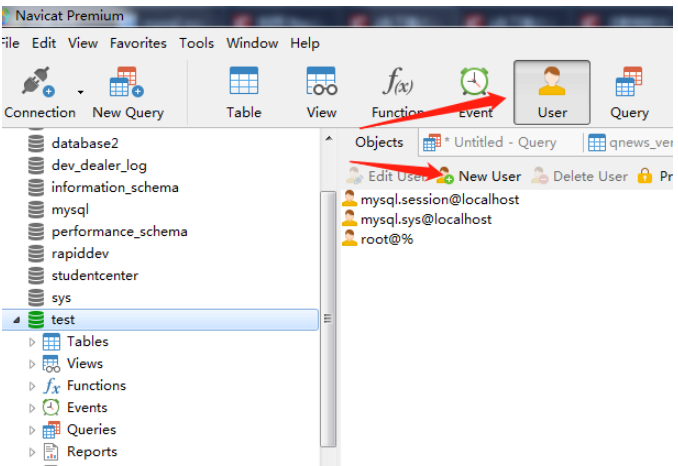
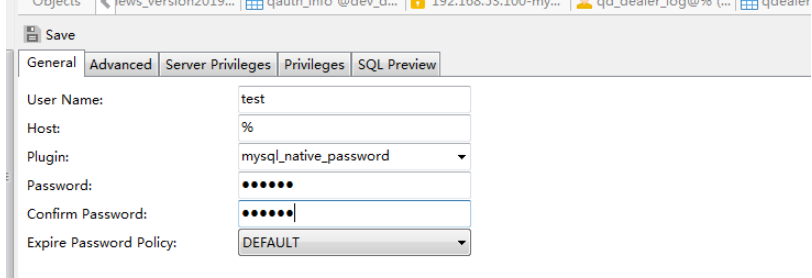
Note: The Host configuration is %, which means all IPs can access
2. Assign permissions to the newly created user
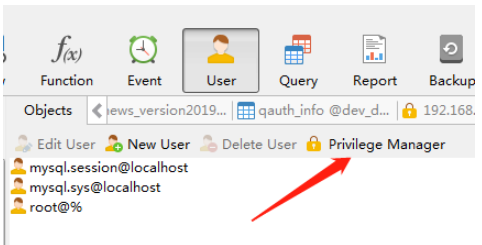


##Key points:
- Adding permissions to the top localhost is valid for all databases
- Select a single database and click Add permissions, it is valid for all databases The selected database is valid
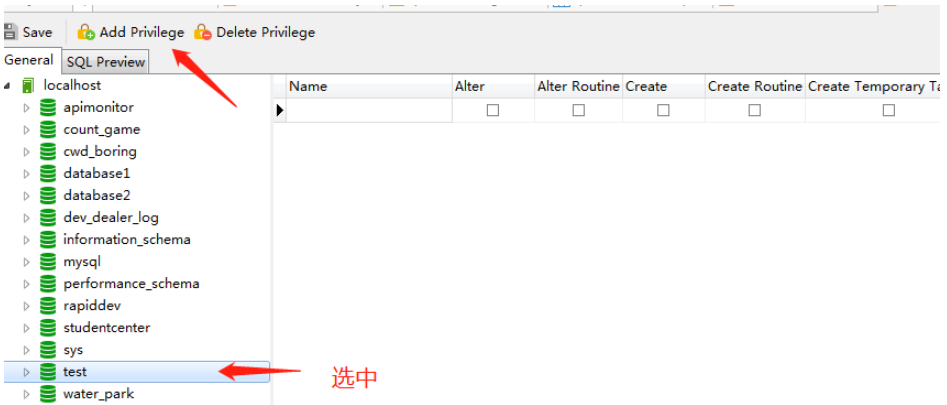
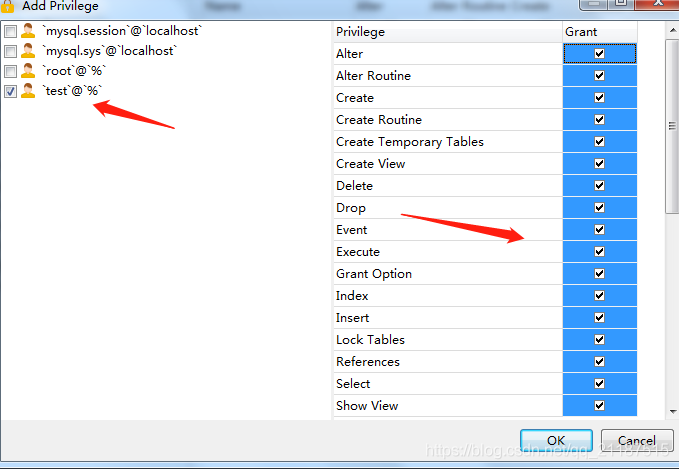
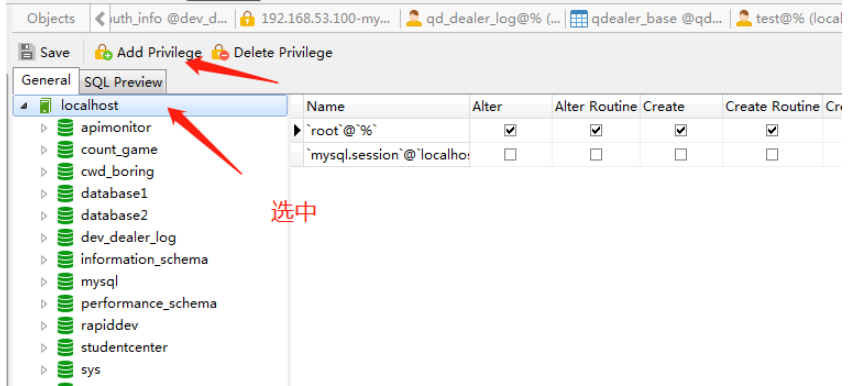
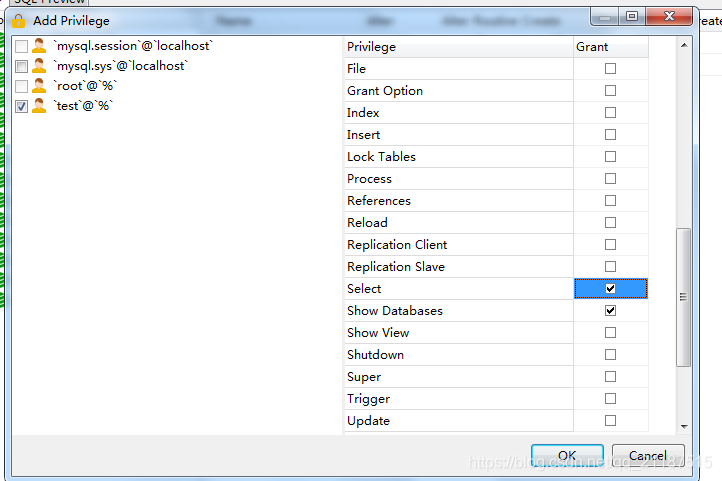
| Permissions | Permission Level | Permissions Description |
| CREATE | Database, table or index | Create Database, table or index permissions |
| DROP | ##Database or tableDelete database or table permissions | |
| Database, table or saved program | Grant permission options | |
| Database or table | ||
| Table | ALTER TABLE , such as adding fields, indexes, etc. | |
| Table | Delete data permissions | |
| Table | Index permissions | |
| Table | INSERT PERMISSION | |
| Table | Query Permission | |
| Table | Update Permission | |
| View | Create View Permission | |
| View | View view permission | ##ALTER ROUTINE |
Stored Procedure |
Change Stored Procedure Permissions |
CREATE ROUTINE |
Stored Procedure |
Create Stored Procedure Permission |
EXECUTE |
Stored Procedure |
Execute Stored Procedure Permission |
FILE |
File access on the server host |
File access permissions |
CREATE TEMPORARY TABLES |
Server Management |
Create Temporary Table Permission |
LOCK TABLES |
Server Management |
Lock table permissions |
CREATE USER |
Server Management |
Create User Permissions |
PROCESS |
Server Management |
View process permissions |
RELOAD |
Server Management |
Permission to execute flush-hosts, flush-logs, flush-privileges, flush-status, flush-tables, flush-threads, refresh, reload and other commands |
|
REPLICATION CLIENT |
Server Management |
Copy Permission |
REPLICATION SLAVE |
Server Management |
Replication Permission |
SHOW DATABASES |
Server Management |
View database permissions |
SHUTDOWN |
Server Management |
Close database permissions |
SUPER |
Server Management |
Execute kill thread permission |
The above is the detailed content of How to solve the problem of configuring mysql database user permissions in Navicat. For more information, please follow other related articles on the PHP Chinese website!

Hot AI Tools

Undresser.AI Undress
AI-powered app for creating realistic nude photos

AI Clothes Remover
Online AI tool for removing clothes from photos.

Undress AI Tool
Undress images for free

Clothoff.io
AI clothes remover

Video Face Swap
Swap faces in any video effortlessly with our completely free AI face swap tool!

Hot Article

Hot Tools

Notepad++7.3.1
Easy-to-use and free code editor

SublimeText3 Chinese version
Chinese version, very easy to use

Zend Studio 13.0.1
Powerful PHP integrated development environment

Dreamweaver CS6
Visual web development tools

SublimeText3 Mac version
God-level code editing software (SublimeText3)

Hot Topics
 1387
1387
 52
52
 How to open phpmyadmin
Apr 10, 2025 pm 10:51 PM
How to open phpmyadmin
Apr 10, 2025 pm 10:51 PM
You can open phpMyAdmin through the following steps: 1. Log in to the website control panel; 2. Find and click the phpMyAdmin icon; 3. Enter MySQL credentials; 4. Click "Login".
 MySQL: An Introduction to the World's Most Popular Database
Apr 12, 2025 am 12:18 AM
MySQL: An Introduction to the World's Most Popular Database
Apr 12, 2025 am 12:18 AM
MySQL is an open source relational database management system, mainly used to store and retrieve data quickly and reliably. Its working principle includes client requests, query resolution, execution of queries and return results. Examples of usage include creating tables, inserting and querying data, and advanced features such as JOIN operations. Common errors involve SQL syntax, data types, and permissions, and optimization suggestions include the use of indexes, optimized queries, and partitioning of tables.
 MySQL's Place: Databases and Programming
Apr 13, 2025 am 12:18 AM
MySQL's Place: Databases and Programming
Apr 13, 2025 am 12:18 AM
MySQL's position in databases and programming is very important. It is an open source relational database management system that is widely used in various application scenarios. 1) MySQL provides efficient data storage, organization and retrieval functions, supporting Web, mobile and enterprise-level systems. 2) It uses a client-server architecture, supports multiple storage engines and index optimization. 3) Basic usages include creating tables and inserting data, and advanced usages involve multi-table JOINs and complex queries. 4) Frequently asked questions such as SQL syntax errors and performance issues can be debugged through the EXPLAIN command and slow query log. 5) Performance optimization methods include rational use of indexes, optimized query and use of caches. Best practices include using transactions and PreparedStatemen
 Why Use MySQL? Benefits and Advantages
Apr 12, 2025 am 12:17 AM
Why Use MySQL? Benefits and Advantages
Apr 12, 2025 am 12:17 AM
MySQL is chosen for its performance, reliability, ease of use, and community support. 1.MySQL provides efficient data storage and retrieval functions, supporting multiple data types and advanced query operations. 2. Adopt client-server architecture and multiple storage engines to support transaction and query optimization. 3. Easy to use, supports a variety of operating systems and programming languages. 4. Have strong community support and provide rich resources and solutions.
 How to connect to the database of apache
Apr 13, 2025 pm 01:03 PM
How to connect to the database of apache
Apr 13, 2025 pm 01:03 PM
Apache connects to a database requires the following steps: Install the database driver. Configure the web.xml file to create a connection pool. Create a JDBC data source and specify the connection settings. Use the JDBC API to access the database from Java code, including getting connections, creating statements, binding parameters, executing queries or updates, and processing results.
 phpmyadmin connection mysql
Apr 10, 2025 pm 10:57 PM
phpmyadmin connection mysql
Apr 10, 2025 pm 10:57 PM
How to connect to MySQL using phpMyAdmin? The URL to access phpMyAdmin is usually http://localhost/phpmyadmin or http://[your server IP address]/phpmyadmin. Enter your MySQL username and password. Select the database you want to connect to. Click the "Connection" button to establish a connection.
 Solution to MySQL encounters 'Access denied for user' problem
Apr 11, 2025 pm 05:36 PM
Solution to MySQL encounters 'Access denied for user' problem
Apr 11, 2025 pm 05:36 PM
How to solve the MySQL "Access denied for user" error: 1. Check the user's permission to connect to the database; 2. Reset the password; 3. Allow remote connections; 4. Refresh permissions; 5. Check the database server configuration (bind-address, skip-grant-tables); 6. Check the firewall rules; 7. Restart the MySQL service. Tip: Make changes after backing up the database.
 Navicat's automatic backup of MySQL data
Apr 11, 2025 pm 05:30 PM
Navicat's automatic backup of MySQL data
Apr 11, 2025 pm 05:30 PM
Steps to automatically back up MySQL data using Navicat: Install and connect to the MySQL server. Create a backup task, specifying the backup source, file location, and name. Configure backup options, including backup type, frequency, and retention time. Set up an automatic backup plan, enable automatic backup, set time and frequency. Preview the backup settings and perform the backup. Monitor backup progress and history.



